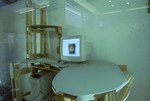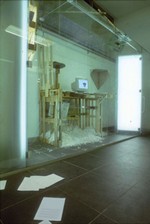text and photos by Michelle Menzies
Charles Bernstein notes that:
to speak of the nonutilizable strata of a poem or a verbal exchange is as problematic as to speak of nonsemantic elements– for what is designated as nonutilizable & extralexical is both useful & desirable while not being utilitarian & prescribable.
Accepting that ’a poem, even though it is composed in the language of information, is not used in the language game of giving information’, what we need is reading which does not attempt to codify meaning, but acknowledges (happily) its insufficiency to embody a text. This idea permeates Annie Bradley and Jamie Kydd’s installation Ape Living, which dwells on the impossibilities of the translation process via. the relational axes of apes, humans and computers. Can artificial intelligence really think like us? Can great apes learn our lexicon? The combination of fascination, manipulation and unease which marks our relationship with simians is only one example of the irreducibly heterogeneous nature of communication across species and linguistic divides: observed by primatologists in the wild, great apes are used simultaneously as pre-human stand-ins in the lab.
In the technologically convoluted installation of Ape Living, whose complexity defies absolutely a reductive summation, the transparent and fruitful inadequacies of internet translation websites like bablefish.com wreak a Babel-like deformation on first-person accounts of ape–human interactions, narratives which are themselves culled from the internet. A process of translation where the same piece of text passes from language to language, pass-the-parcel like and unravelling wildly as it goes, is precipitated and accelerated by the viewer’s verbal interaction with an animated 3-D ape, whose head floats aimlessly in the white background of a computer screen installed in the exhibition. Impotent, pathetic and more than slightly deflationary, this digital animal tries hopelessly to transcribe human spoken language in real-time, its doomed efforts exponentially linked to the churning of text through the cycle of internet translation. The results of this process, spat out intermittently by a printer, read like language which has been poured into a bucket and sloshed around vigorously:
Sultan was a chimpanzee in one of Kohler’s experiments. He was not encaged, but placed in a room where bananas were too high for him to reach. The solution to the problem lay with the boxes that were strewn around the room. Sultan stacked the boxes on top of each other… …climbed the platform and grabbed the bananas.
After five translations (English-German-English…etc.):
Sultan is a scimpanzè in the direction of the experiment of Kohler. He is not encaged, but he too strongly arranges in the causes of banana in the room which is stopped low with it cannot arrive. With him it is espanado with the solution of the following question them these places of the side part then the box it in the room. Sultan piled up inside above above box it…… this it regulated the platform in inside if it advanced leave and that it seizes banana.
Annie Bradley writes: ’the first tool use [by primates] is thought to have forced language from our voice boxes in order to free up our hands. Did the potential of our opposable thumbs create this situation? What is the nature of our connection to technology, do we mould it or does it, as habitat, mould us?’ These are pertinent questions to raise as the human-technology connection becomes increasingly fraught, and our bodies, yet un-evolved for new purposes, begin to feel the impact of their collision. They are equally appropriate points with which to consider the effect of language, whose insidious capacity to speak the speaker has been charted definitively by both psychoanalysis and poststructuralism over the twentieth century. Indeed, the discursive nature of language is utterly crucial to this debate, and as its perennial incommunicability spreads through new species and technologies, the politics and import of communication’s noisome unmanageability become increasingly charged.
This article is ©copyright 2004 Michelle Menzies
http://window.auckland.ac.nz/archive/2004/04/onsite.html



